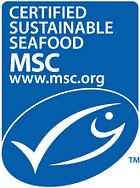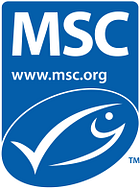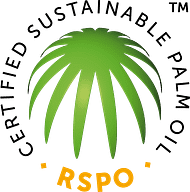That’s ‘six’ symbols for the sustainable shopper… put your eyes back in!
Yes, if a gallery of ‘hunks’ and ‘hotties’ scantily clad in sustainable wears is what you seek, I’m afraid disappointment lies in store. However, if you find yourself purchasing products willy nilly* without knowledge of their origin, this is the post for you.
From tuna steaks to coffee and shampoo, shopping sustainably is easier than you might think. What’s more, one of the simplest ways to do it is to look out for the logos. So feast your eyes on Six Symbols For The Sustainable Shopper…
*Incidentally ‘Willy Nilly’ also happens to be a crippling medical condition.
Marine Stewardship Council (MSC)
Fish puns aside (there’s a time and plaice for that sort of thing and one mustn’t be fishetious), there’s nothing fishy about the MSC and it’s high tide we recognised it!
Whether you covet the cod, savour the salmon or… orange an oyster (well you try finding one for it!), keeping an eye out for the Marine Stewardship Council’s blue fish logo will ensure you can do so in good conscience.
Since its launch in 1997, the MSC has developed a set of strict sustainability standards that any company with a hunger for its logo must meet. So if you spot the blue fish, it’s a sustainable dish.
That means no trawlers sweeping entire populations from the sea, no destructive techniques (such as explosives) have been used and no lasting damage has been made. Plus it’s handled with care along the way!
Choosing MSC certified produce also means choosing a healthy, biodiverse, carbon-storing ocean which is important because the oceans produce up to 70% of the oxygen we breathe. Thus, not only will you be securing tomorrow’s prawn cocktail but tomorrow’s breath of fresh air!
So next time you buy your kipper, don’t come a cropper, keep a weather eye out for the MSC’s blue seal of approval… which is, in fact, a fish. You’ll soon sea life will taste better!
Fancy learning more? Give the pic a click and take the plunge into a sustainable sea! Offended by the puns? Get in line! Haha get it!? Like a fishing line!
.. Ah forget it. I’m wasted on you..
The Roundtable On Sustainable Palm Oil (RSPO)
In recent times it’s become increasingly apparent that palm oil is everywhere. It makes your toothpaste froth, your chocolate smooth and even wards off vampires (ever seen Dracula brush his teeth? Didn’t think so).
However, in truth palm oil has one particularly problematic trait. That is, that virgin rainforest is ripped up to make way for plantations of the stuff. Now we all know why that’s not good…
Clearing of rainforest = loss of habitat = loss of biodiversity = loss of carbon storage = release of carbon into the atmosphere = rapidly accelerating climate change = post apocalyptic landscape
= Hunger Games.
However, there is light at the end of the tunnel and it comes in the form of the RSPO. Yes, the Knights of the Roundtable On Sustainable Palm Oil are a non-profit organisation born with one aim: to make sustainable palm oil the norm. Hence, much like the MSC, they’ve developed a set of environmental and social criteria that certified companies must meet.

They include crackers like:
“No primary forests or areas which contain significant concentrations of biodiversity or fragile ecosystems, or areas which are fundamental to meeting basic or traditional cultural needs of local communities, can be cleared.”
In a nutshell, such parameters ensure that any product bearing the RSPO’s lovely palm logo contains palm oil from an established source. So next time you’re looking to indulge in some chocolate or purchase shampoo, keep your eyes peeled for the palm. It even comes in black – how slimming!
Rainforest Alliance
Another non-profit organisation with sustainability at its heart is the Rainforest Alliance. Counterintuitively, this lot work to protect whales, dolphins and porpoises… ok, not really – that’s Aquaman. But having said that, the RA’s actual task isn’t too dissimilar from that of Earth’s mightiest heroes.
Yes, in case you hadn’t guessed, they’re all about preserving forests. However, their work doesn’t end there, for the Alliance also works tirelessly to support those who live and work in and around said forests.
Moreover, these efforts combine to help keep the evil forces of Climate Change at bay. As a result, any product that bears their little green frog is guaranteed to be both environmentally and socially sustainable.
But don’t take my word for it, take theirs:
“The Rainforest Alliance certification seal means that the product (or a specified ingredient) was produced by farmers, foresters, and/or companies working together to create a world where people and nature thrive in harmony.”
So to conclude, that’s:
- Promoting the best practices to protect forests
- Maintaining the health of trees, soils and waterways
- Promoting responsible land management methods to increase carbon storage
- Providing robust strategies to address human issues such as child & forced labour, gender inequality and the violation of indigenous land rights
- Helping lift rural people out of poverty
Who needs Aquaman, eh!?
Forest Stewardship Council® (FSC)
Have you ever taken a soothing stroll through a forest and noticed an army of heavily camouflaged stewards watching your every move? Neither have I – isn’t camouflage good!
Ok realistically the Forest Stewardship Council aren’t lurking in your local woodland waiting for you tread on a toadstool. However they are constantly working to preserve the biodiversity of forests around the world.
With that in mind, since their inception in 1993, the lovely people at the FSC have come up with ten commandments that… what? Already taken?… By who? Well he doesn’t have to know, does he… he knows everything!? Sounds a bit convenient… ugh, finnnne…
.. The FSC have come up with ten principles to which any product marked with their “tick tree” symbol must adhere. From Compliance with Laws to High Conservation Values, this non-profit organisation upholds tight sustainability standards.
Don’t worry, I’m not going to recite them all for you here; to do so would take a lot of time and, quite frankly, I was hoping to catch up on Antiques Roadshow. However, for good measure, here’s a taste of what they enforce:
- “The Organisation shall comply with all applicable laws, regulations and nationally-ratified international treaties, conventions and agreements.”
- “The Organisation shall contribute to maintaining or enhancing the social and economic wellbeing of local communities.”
- “The Organisation shall maintain, conserve and/or restore ecosystem services and environmental values of the Management Unit, and shall avoid, repair or mitigate negative environmental impacts.”
- “The Organisation shall not commit adultery.”
Alright, alright that last one isn’t theirs but it remains true – they’re a reliable life partner! So next time you’re planning to purchase a forest-sourced product (timber, natural rubber, textiles etc.), look for the FSC’s symbol. It’s a sure sign of sustainability!
The Carbon Trust
Admittedly it’s difficult to trust anything affiliated with carbon at the moment. In fact, one might argue that it’s currently the most suspicious of all-natural substances. That is apart from ‘dickite’, which brought last year’s International Kite Festival to a controversial end… any road, the Carbon Trust deserve our trust and here’s why.
“The Carbon Trust’s mission is to accelerate the move to a sustainable, low carbon economy and, as such, we will only consider certifying organisations and products that align with this mission in an effective and meaningful way.”
With that in mind, the Carbon Trust offers a selection of certifications that organisations can sow to their sash. These include (but are not limited to): the Carbon Trust Standard for Carbon, Water and Waste… and also Helping an Elderly Person Across a Busy Road. But traffic-troubled oldies aside, if you tick all three boxes you can even achieve the Carbon Trust’s Triple Standard!
However, while this is encouraging, we’re not here to discuss organisations and geriatric road-crossers. Nay! We’re here to discuss sustainable shopping. As a result, I’m going to focus on the Carbon Trust’s footprint labels for products (and there’s nothing you can do to stop me… no wait, don’t leave!).
The Carbon Trust’s Product Labels
Basically, if you see a product labelled with a little black footprint, it means that its carbon footprint has been certified by the Carbon Trust (please, contain your surprise). More specifically, there are four main types of product labels, so pop your monocle on and lean in a little closer, and you’ll soon see which yours has met:

This label shows that the carbon footprint for the product has been measured and certified against an internationally recognised standard, such as PAS 2050, GHG Protocol Product Standard or ISO14067. So you’re good to go!

Much like the bound foot of an 18th Century Chinese Noblewoman, this label demonstrates that the product’s footprint is reducing year on year. Plus, it shows a commitment to achieving ongoing reductions. So you can be sure you’re supporting a product that’s proactively reducing its climate impact and probably has crippling arthritis.

This label shows that the product’s carbon footprint is achieving ongoing reductions and any outstanding emissions are offset in accordance with the international PAS 2060 standard.

This beauty shows that the lifecycle carbon footprint of a product is significantly lower than the lifecycle carbon footprint of the market-dominant product in its category.
Exciting stuff, eh! .. Hey, wake up!
To conclude, yes, in an ideal world zero carbon’s the goal. However, for now, the Carbon Trust’s labels are a clear indication of products that have footprints either reducing, neutral or lower than comparable products in the market. Better to buy something that’s low, reducing or carbon-neutral than something carbon positive, eh! So follow the footprints, friends!
COSMetic Organic and Natural Standard (COSMOS)
If you’re in the market for sustainable cosmetics, and lord knows I should be (such is the decline of my complexion that yesterday, while out for an afternoon stroll, a passing child clocked me and informed his mother that they’d just seen a walnut in a hat), then the COSMetic Organic and Natural Standard (COSMOS) are the clan for you.
An international enterprise comprised of Germany’s BDIH, France’s Cosmebio and Ecocert, Italy’s ICEA and the UK’s Soil Association, the COSMOS-standard…
“.. defines the criteria that companies must meet to ensure consumers that their products are genuine organic or natural cosmetics produced to the highest feasible sustainability practices.”
As such, COSMOS have four main logos that you can look out for when buying your slap… unfortunately they’re yet to grant me permission to display them on here, so follow this link for a VIP premiere.
COSMOS Organic
If you see this logo, it means the product boasts none of the following: animal testing, GM ingredients, ‘controversial chemicals’ (chemicals that are very opinionated), parabens and phthalates or synthetic colours, dyes or fragrances.
Likewise, it does have: Sustainable sources, natural colours and fragrances, biodegradable, minimum packaging with maximum recycled content and protects biodiversity.
COSMOS Natural
Only slightly different to COSMOS Organic, this little number means your item contains natural ingredients but not all of them are organic.
COSMOS Certified
Your product contains ingredients that have been organically processed.
COSMOS Approved
The item contains non-organic raw materials/ingredients which have been approved by COSMOS and used in the composition of the product.
Well wasn’t that fun! … I thought I told you to WAKE UP AND PAY ATTENTION!? I’m about to sum this section up and my summations are usually profound… ahem…
.. One doesn’t require cosmetics to be beautiful. Beauty comes from within. However, if one must invest in the latest lippy, then doing so sustainably will not only save the planet, but save one’s soul… or something like that. Now if you’ll excuse me, I’m going to plunge my face into a pool of sustainably sourced mud to iron out the creases.
Look out for those logos!









Great article! Informative and enjoyable reading, plenty to look out for in future purchases.
The humour is a bonus, thanks for that. It’s evident you care about our planet and it’s future.
Thanks a bunch and thank goodness you think it’s funny! Save the planet, have a laugh – can’t be bad!
Another amazing article! Super informative and funny as always. Especially liked the info about COSMOS, will be looking out for them 🙂
Keep those articles coming!
Thanks Vicky! Chuffed you enjoyed it – I’ll keep on at it!